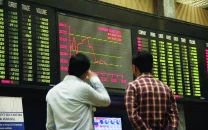Jul-Sept trade deficit shrinks 21%
Imports provide some relief, though exporters couldn’t benefit from rupee’s fall

Pakistan’s trade deficit shrank over one-fifth to $9.2 billion in the first quarter of current fiscal year solely on the back of a steep fall in imports as exporters failed to take advantage of 100% currency devaluation over the past five years, reported the Pakistan Bureau of Statistics (PBS) on Tuesday.
The gap between imports and exports came in at $9.2 billion in the July-September quarter, which was 21.4%, or $2.5 billion, less than the comparative period of previous fiscal year.
Trade figures were released by the national data collecting agency two days before a scheduled meeting between Finance Minister Ishaq Dar and exporters on the discontinuation of electricity subsidies due to the lack of funds.
According to the PBS, exports stood at a mere $7.1 billion, up $129 million, or 1.8%, during the July-September period.
The unimpressive export proceeds should be a matter of concern as they indicate that the country will not only miss the annual export target of nearly $38 billion, but the receipts may also be lower than the previous fiscal year.
Over the past six months, the local currency has devalued by 33%, while the total devaluation in the past five years has almost been 100%. Yet, the monthly export bill is hovering around $2.5 billion, barring last fiscal year when it briefly touched $3 billion due to high global commodity prices.
This raises questions over the country’s export policies that are backed by energy subsidies, which stood at around Rs110 billion in the last fiscal year.
Imports amounted to $16.3 billion during the July-September period, down $2.4 billion, or 12.7%, the report stated.
In this connection, the federal government and the State Bank of Pakistan (SBP) have taken administrative measures to contain imports. A ban had also been placed, but it proved to be largely ineffective.
The central bank is examining almost every letter of credit, has introduced import quotas and even restricted imports through open accounts.
Separately, during a parliamentary committee hearing, State Bank of Pakistan (SBP) Governor Jameel Ahmad on Tuesday did not give a timeline for lifting the import restrictions, saying that the inflows and outflows of the US currency would determine the timing to relax the conditions.
Besides, industrialists are complaining that due to these limitations, they have not been able to import goods required for producing export products.
While the government has lifted the ban on imports, other restrictions continue to remain in place, which include the vetting of letters of credit by the central bank. However, the SBP governor said that only 10% to 12% of the total imports were now subject to the restrictions.
On a month-on-month basis, exports contracted 3.8% to $2.4 billion in September 2022 over the preceding month, a dip of $95 million. Imports stood at $5.3 billion with a drop of 13.2%, or $802 million, over the preceding month.
As a result, the monthly trade deficit contracted to $2.9 billion, which provided a relief of $707 million, or nearly one-fifth. Every dollar matters for the government that is struggling to revive inflows from abroad, despite the revival of International Monetary Fund (IMF) programme.
In order to ensure an increase in external financing, Finance Minister Ishaq Dar on Tuesday held separate meetings with ambassadors of the United Arab Emirates (UAE) and Qatar, aimed at securing their support for meeting Pakistan’s gross external financing requirement. The UAE has committed an investment of $3 billion.
For current fiscal year 2022-23, the government has set the trade deficit target at $27.8 billion, which requires a reduction of 42% from last year’s deficit.
Import target for the current fiscal year is $65.6 billion, which will require a reduction of 22% in the import bill.
In the last fiscal year, Pakistan’s trade deficit widened at an unsustainable pace of 55%. The higher deficit took a heavy toll on the country’s foreign exchange reserves, which have dropped 60% from the peak of $20 billion in August last year to $8 billion last week.
Furthermore, on a year-on-year basis, exports showed a marginal contraction of less than 1% in September and stood at $2.4 billion against $2.5 billion in the same month of previous year, according to the PBS. In absolute terms, there was a dip of $22 million in exports.
Imports were lower by $1.3 billion, or nearly 20%, in September, compared to the same month a year ago. Consequently, the trade deficit narrowed by over 30% year-on-year to $2.9 billion in September, showing a reduction of $1.3 billion.
Published in The Express Tribune, October 5th, 2022.
Like Business on Facebook, follow @TribuneBiz on Twitter to stay informed and join in the conversation.


















COMMENTS
Comments are moderated and generally will be posted if they are on-topic and not abusive.
For more information, please see our Comments FAQ